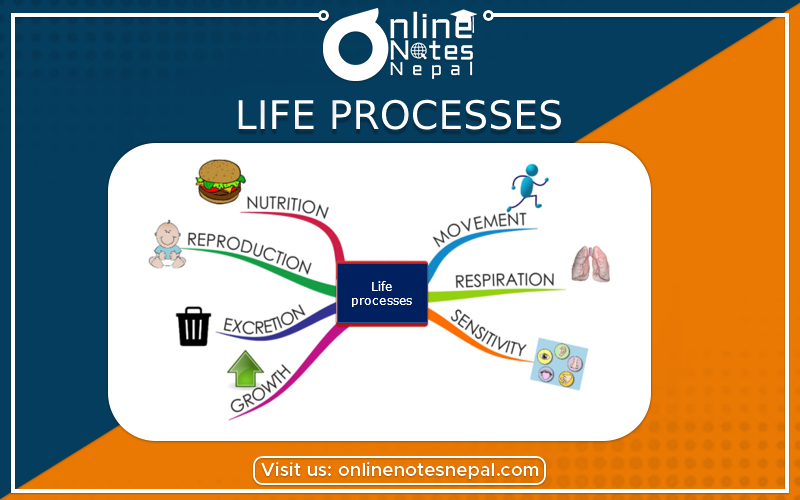Published by: Nuru
Published date: 18 Nov 2021

In this topic, Life Processes we discussed about the brief description of Life Processes for Grade 8 Science Notes. It is a Reference notes for Grade 8.
Reproduction
Reproduction is the process by which all living organisms produce new offspring of their own kind.
Reproduction maintains continuity of life, as by reproduction young ones replace the old and dying ones. These young ones feed, grow and reproduce again.
Types of reproduction:
There are two types of reproduction. They are:
Asexual reprocution
Sexual reproduction
Asexual reproduction:
The reprocution which takes place without the fusion of male and female gamete is called asexual reproduction.
It's basic features are:
Types of asexual reproduction:
Fission
Budding
Fragmentation or regeneration
Sporulation
Vegetative propogation
Fission:
It is that type of asexual reproduction in which a unicellular organism divides into two or more daughter organisms. It is common in protozon such as amoeba, paramecium, plasmodium, etc. It is of two types:
Binary fission
Multiple fission
Binary fission:
It is that type of asexual reproduction in which a unicellular organism divides into two daughter organisms. It occurs in favourable condition. It is common in amoeba, paramecium, bacteria, euglena, etc. During this process, first of all the nucleus of the cell divides into two. This is followed by the division of cytoplasm and then splits into two daughter cells. These daughter cells grow and develop into adult individuals.
| Binary fission | Multiple fission |
| An organism divides into tw daughter. | An organism divides into many daughters. |
| It occurs during favourable condition. | It occurs during unfavourable condition. |
Multiple fission:
It is that type of asexual reproduction in which a unicellular organism divides into many daughter individual. It occurs during unfavourable condition. Amoeba, plasmodium, etc show such reproduction.
Budding
The process of formation of offspring from an out growth of bud of a parent. It is found in hydra and yeast.
Process of budding:
Budding in yeast:
Yeast is a unicellular fungi. It grows in sugar soultion and converts sugar into alcohol. A small bud develops in the yeast cell. Nucleus divides into two and one of the nucleus migrated to the bud. The bud gets separated from the parent cell to form new yeast cell. During favourable condition, budding occurs so rapidly that the newly formed yeast cell begins to rerproduce by budding before seperating from parent cell. As a result, the chain of yeast cells can be seen.
Fragmentation or Regeneration:
It is that type of asexual reproduction in which the parental body breaks into two or more fragments and each body fragment develops into an organism. Tapeworm, Planeria, etc show such reproduction. The ability of organisms to replace its body parts is called regeneration.
Q. Tapeworm reproduces by regeneration what does it mean?
It means that the body of tapeworm breaks down into a number of small pieces and each small pieces grows into an individual.
Sporulation:
It is the process of asexual reproduction by the formation of speores. Spores are microscopic unicellular units in reprocution. Spores are produced in spore sacs or sporangia. When spores become mature, the sporangia burst and the spores are blown here and there by wind. These spores germinate into new individuals under suitable condition. This method of reproduction occurs in non flowering plants like mucor, mass, fern, etc.
Vegetative Propogation:
Flower is the reproductive part of a flowering plant. The parts of plants other than flower are called vegetative parts. Example; root, stem, leaf, etc. Vegetative propogation is the process of forming new plants like stem, root, leaf, etc.
Vegetative propogation by stem
Rose, sugarcane, potato, ginger, etc propogate by stem.
Vegetative propogation by root
Plants like sweet potato, Yam propogate by root
Vegetative propogation by leaf
Plants like bryophyllum, Begonia, etc reproduce by leaf. Leaves of these plants develop buds on the margin which develop buds on the margin which develop into a new plant.
Advantages of Vegetative Propogation:
Q. Sugracane is planted by cutting into pieces. What type of reproduction is it? Give 3 reasons of its appliation in sugarcane.
It is vegetative reproduction by stem.
Reasons:
It does not produce seeds.
It is easier, cheaper, and faster method of reproduction.
Sexual reproduction:
It is that type of reproduction in which there is formation and fusion of male and female gametes.
It's basic features are:
fertilization:
The process of fusion of male gamete and female gamete to form a zygote is called fertilization. There are two types of fertilization. They are:
External Fertilization
Internal Fertilization
External Fertilization:
The fertilization which occurs outside the body of female is called external fertilization. External fertilization usually occurs in water. Fish, frog, show external fertilization.
Internal Fertilization:
The fertilization which occurs inside the body of female is called internal fertilzation. Reptiles, birds, mammals, insects show internal fertilization.
| External fertilization | Internal Fertilization |
| It takes place outside the females body. | It takes place inside the females body. |
| Zygote is outside the female's body. | Zygote is inside the female's body. |
| It is common in fish, frog. | It is common in reptiles, birds, mammals, etc. |
| Asexual reproduction | Sexual reproduction |
| It involves a single parent. | It involves two parents of opposite sex. |
| Fertilization does not occur and It is rapid mode of reproduction. | Fertilization occurs and It is slower mode of reproduction. |
| Daughter individuals are genetically similar to parents. | Daughter individuals are genetically different from parents due to variation. |